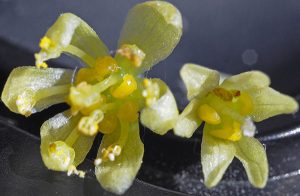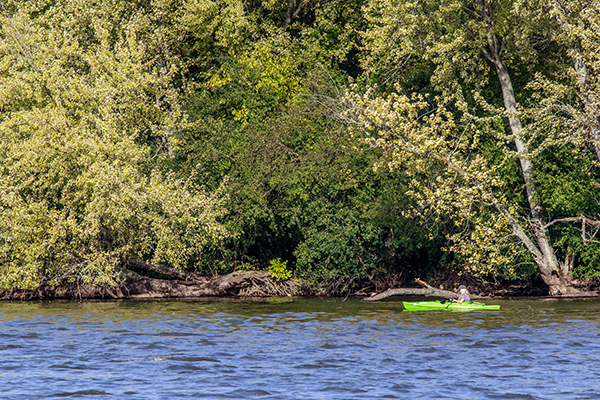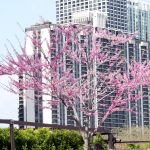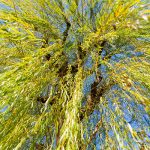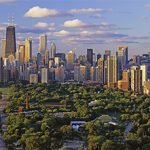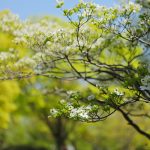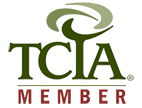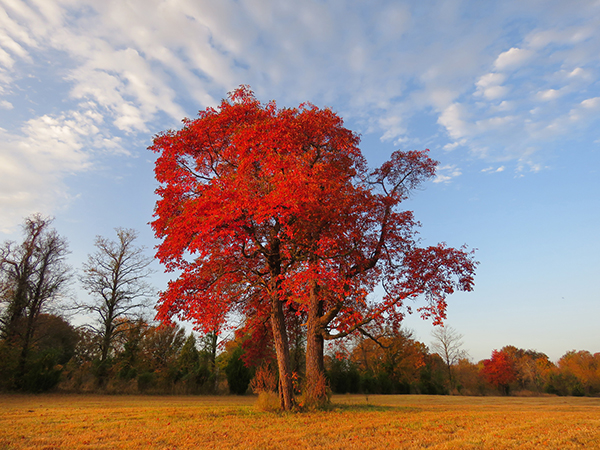
The beautiful fall foliage of the Sassafras Tree is seen through the Chicagoland, IL suburbs every autumn. Learn more about the Sassafras Trees of Illinois in this article.
This week’s installment of our series on the native trees of the Chicago area highlights the sassafras tree. Sassafras trees have a stunning appearance both in season and in the fall because of their white flowers that bloom in the spring and the vibrant yellows, oranges, and reds of its leaves in the fall. One of the most defining characteristics of the sassafras tree is the aromas that come from all parts of the tree, including the leaves and branches. People have long used sassafras roots, leaves, and fruits for a variety of culinary purposes such as flavoring root beer due to its aromatic qualities. The sassafras tree has also been historically used by many cultures for medicinal purposes.
The showy fruits, flowers, and fall colors of sassafras trees make them an attractive option for your yard or landscape. In the wild, these trees tend to grow in thickets which must be taken into consideration before planting because this may not be desirable for most landscapes. Sassafras trees will not only provide shade and natural beauty on your property, but also a light, pleasant aroma. They also attract a variety of birds including game birds and song birds as well as small mammals. In this article, we will discuss the defining characteristics of sassafras trees, the biggest threats to these trees, and proper sassafras tree care to keep these plants in good health.
At Hendricksen Tree Care, our arborists are passionate about caring for Chicago’s native trees including the sassafras tree. We provide complete tree care including tree treatment and maintenance services to help your sassafras trees continue to thrive.
Characteristics of Sassafras Trees
Sassafras trees are mostly medium sized trees that grow between 15 and 40 feet tall on average, but they have been known to grow as tall as 100 feet. A sassafras tree in Owensboro, KY stands over 100 feet tall and is the tallest sassafras tree on record. The sassafras tree native to the Chicago area, Sassafras albidum, is a deciduous tree that is also dioecious which means that male and female flowers do not grow on the same tree. The flowers of both sexes look similar as each type develops six greenish yellow pedals and they are usually the same size while in bloom. The major difference between the male and female sassafras flowers is that the male flowers have nine stamens in the center while the female flowers have a central pistil surrounded by six smaller stamens.
The natural aroma, fall colors, and variety of leaf patterns on a single tree are the most recognizable characteristics of a sassafras tree. The aromas of a sassafras tree are the strongest when the leaves are crushed or when the bark of the branches is cracked or removed. Sassafras trees live about 100 years on average but with the proper tree care, they can live for several hundred more.
Below are brief descriptions of the main characteristics of sassafras trees:
-
- Height: Most sassafras trees grow between 15 and 40 feet in height, but they can reach up to 100 feet. These trees tend to be pyramidal or irregular with their shape and can have a width of 24 to 40 feet.
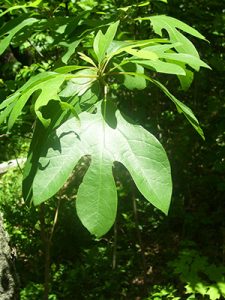
Learn how to recognize the unique leaves of the Sassafras tree in Illinois. Photo courtesy of wikipedia.
- Leaves: One of the unique characteristics of the sassafras tree is the different leaf shapes that can be found on a single tree. Sassafras leaves can be one of three different shapes: oval with no lobes, bilobed or mitten shaped, and trilobed which resembles a mitten but with two “thumbs.” The lobes of the leaves are rounded with smooth edges and when crushed, the leaves give off a citrus scent.
- Flowers: As mentioned above, sassafras trees are dioecious which means that male and female flowers grow on separate trees. These flowers start as clusters of buds early in the spring and bloom in in the middle of the spring. Both male and female flowers have six greenish yellow pedals that are similar in size and appearance. Sassafras flowers are not particularly showy, but the female flowers are replaced by drupes which are showier then the flowers.
- Fruit: The fruit produced by a sassafras tree are bluish black drupes the grow on red stalks. These fruits only appear on female trees in place of the fertile female flowers.
- Bark and Branches: The branches of a sassafras tree are sympodial and smooth and give off a spicy aroma when scratched or snapped. They also tend to grow in thickets in the wild. The bark can be orangish brown to reddish brown in color and has well defined ridges and burrows.
Sassafras Trees Native to Illinois
There are only 4 known species of sassafras trees in the world, one of which is extinct. Two of the existing species of sassafras trees are found in East Asia while the other species is found in North America. The different species of sassafras trees are explained in further detail below:
- Sassafras albidum: This is the sassafras species native to North America and the Chicago area. These trees are found as far north as Ontario, Canada; as far south as central Florida, and as far west as southern Iowa and East Texas.
- Sassafras hesperia: This is the extinct species of sassafras tree that grew in western North America. Its existence is known from fossils.
- Sassafras tzumu: This species of sassafras is found mostly in central and southwest China. Unlike sassafras species in North America, these trees are monoecious which means they have male and female flowers on the same plant, and they are more likely to have trilobed leaves.
- Sassafras randaiense: This species is also known as the Taiwanese sassafras because it is found in Taiwan. Like the Sassafras tzumu, this species is also monoecious and has a higher frequency of trilobed leaves.
Threats to Sassafras Trees in Chicago: Diseases and Pests
Sassafras trees do not have as many natural threats to their health as other tree species such as the ash tree, but there are still several diseases and pests that can attack them. The following are the biggest threats to the sassafras tree:
- Laurel wilt disease: This disease is a fungal disease that is spread by the redbay ambrosia beetle, an invasive species from Asia. These beetles tunnel into the sapwood of affected trees which isn’t much of a problem by itself, but the fungus that the beetle introduces into the sapwood can cause a stoppage in the flow of nutrients which leads to dieback in the crown. The main symptoms of laurel wilt disease include dark streaks in the wood and wilting of the leaves and stems. Affected trees may die within a few weeks of becoming infected. This disease can affect a variety of tree species in the Lauraceae family which includes redbay and avocado trees, and it affects these other species of trees more often than sassafras trees.
- Nectria canker: Nectria canker is a disease caused by a fungus that produces target-like lesions on the stems and trunk of the tree. The cankers start is shallow lesions of discolored bark, and the tree reacts by forming a callus ridge around the lesion to prevent it from spreading. These cankers tend to return each season and can eventually spread to the branches, resulting in branch dieback and eventually the death of the tree.
- Japanese beetle: The Japanese beetle is an invasive species of beetle with no natural predators in North America. These beetles are notorious for defoliating trees and sassafras leaves are among their favorites. Adult Japanese beetles feed on foliage and release pheromones to attract more beetles to a tree, speeding up the defoliation process. They start at the top of the tree and skeletonize the leaves they eat, working their way down the plant.
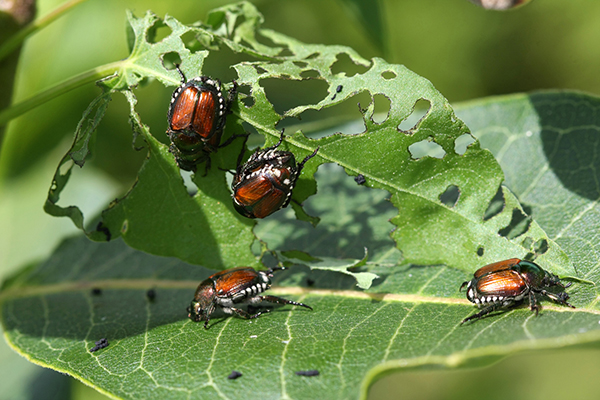
The Sassafras Tree is one of the favorite snacks of the destructive Japanese beetles in Chicago, IL. Hendricksen Tree Care can help you protect for Sassafras Trees from pests all year round.
- Sassafras borers: Sassafras borers are beetles that lay their eggs in areas of the bark chewed by the female. The damaged caused by the chewing can kill the branch. The larvae enter the main stem after they hatch and feed on the sapwood as they burrow further down into the tree and roots. When the larvae mature, the adults emerge by chewing a hole through the bark. Sassafras trees affected by sassafras borers have wilted foliage, frass excrement along the main stem, bored tunnels in the sapwood, and oval like holes where the adults have emerged. A tree infested by the sassafras borer can die within a couple of years.
Illinois Sassafras Tree Care Tips
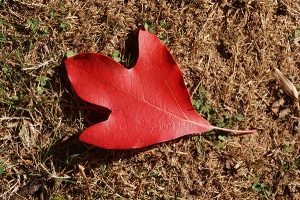
The following tips will help keep your Illinois Sassafras Trees looking good all year long, especially in the Fall with their bright red leaf color.
Sassafras trees are relatively easy to maintain. They do best in acidic soil that is moist but well-drained, and they have some tolerance to alkaline soils and drought conditions. When planting a sassafras tree, it is best to put it in a location where it can get direct sunlight for half the day and partial sunlight for the other half. The biggest challenge with sassafras trees is pruning the branches if they grow into thickets.
The following tips will help you care for your sassafras trees:
- Mulching: Mulching is important for retaining moisture, protecting the roots from the cold, and preventing weeds. Apply a thick layer of mulch around the base of the tree but keep the mulch at least 2 inches from the trunk to prevent fungus.
- Watering: Sassafras trees do not need much watering because they prefer well drained soil and can withstand some drought like conditions. You should water them 2-3 times per week when the top layer of soil is dry in the summer and fall. Make sure to water them thoroughly and deeply so the water reaches the roots but be careful not to over water them.
- Fertilizer: A newly planted sassafras tree does not need fertilizer until its second growing season. Fertilizing a young tree can stunt the growth of the root system. When a sassafras tree is established, you should fertilize it twice per year; once in February and once in mid-June.
- Pruning: If your sassafras tree does not grow into thickets, it will not need much pruning. Pruning should be done late in the winter or early in the spring to help promote strong structural growth. Thickets may need to be pruned more often. Talk to a professional arborist to determine how often your sassafras tree needs pruning.
Professional Tree Care Services for your Sassafras Trees in Illinois
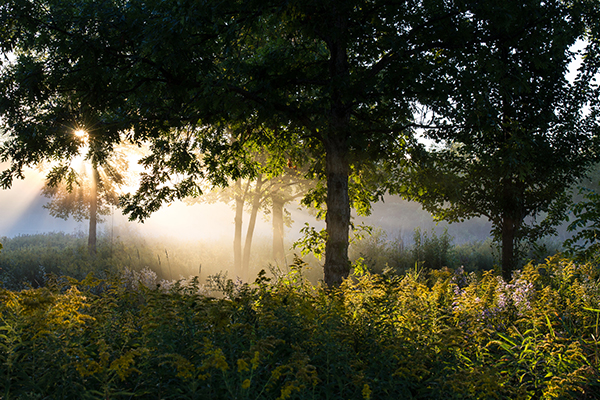
Sassafras Trees can make both natural forests, residential & commercial landscapes stand out all year long in Illinois. Consider planting a Sassafras Tree this year!
Sassafras Trees can make both natural forests, residential & commercial landscapes stand out all year long in Illinois. Consider planting a Sassafras Tree this year!
Sassafras trees make a great addition to yards and landscapes because of the shade they provide, their pleasant aromas, and brilliant fall colors. They are susceptible to damage from tree fungal diseases and pests, but the threats to the sassafras are modest compared to other trees. Following the tree care tips provided in this guide and watching out for signs of a disease or pest infestation will help you keep your sassafras trees healthy. If your sassafras trees are showing signs of a disease or pest infestation, or if they need some pruning, contact the tree care service professionals of Hendricksen Tree Care. Our arborists can diagnose diseases and infestations, provide proper pruning, and assist you with general care and maintenance. We are proud to provide effective care for the native trees of Illinois in Arlington Heights, Palatine, Northbrook, Lake Zurich, and the surrounding north and northwest Chicago suburbs.
Don’t forget to look for the next installment of our series about the native trees of Chicago, IL.
